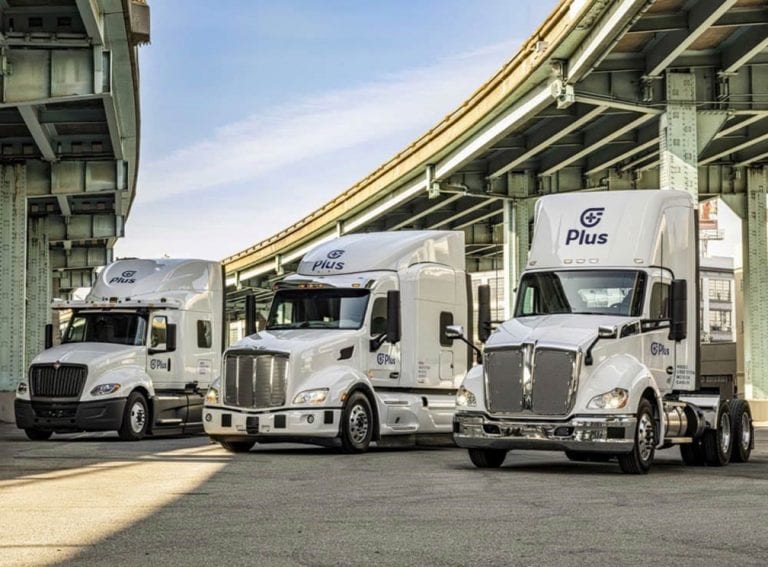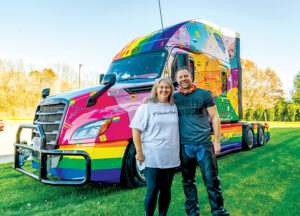CUPERTINO, Calif. and COLUMBUS, Ind. — Plus and Cummins Inc. are collaborating to create the first supervised autonomous trucks powered by a natural gas engine.
While Plus is a company focused on self-driving truck technology, Cummins is a manufacturer of diesel and alternative fuels engines. The two companies have been working together for five years, but this venture will be the first time a natural gas engine has been paired with autonomous technology, according to a statement from Plus.
“Sustainable transportation is good for business and for humankind,” said Shawn Kerrigan, chief operating officer and co-founder of Plus. “This is an extraordinary collaboration that brings together two excellent engineering teams to create an innovative, production-ready solution that will have tremendous business and environmental impact. Working with Cummins on this truly meaningful product is a natural extension of our long-standing partnership.”
With artificial intelligence (AI), the trucks powered by the Plus system combined with a Cummins natural gas engine can be more fuel efficient, according to the two companies. Cummins’ natural gas engines have reduced smog-forming emissions by 90% compared to current Environmental Protection Agency (EPA) standards for nitrogen oxide air pollutants, according to Plus.
“Integrating Cummins’ state-of-the-art natural gas-powered engines into Plus’s industry-leading supervised autonomous trucks enables a new kind of transportation solution and offers customers even greater choices to meet their emissions goals,” said J. Michael Taylor, general manager of Cummins. “Cummins engines can power nearly every type of vehicle and application globally, so the integration of our natural gas powertrains for autonomous driving applications is a logical next step to provide customers with solutions that align with their specific business requirements.”
Although the two companies have been partners for a while, this new venture is the product of continued collaboration, according to Lauren Kwan, vice president of marketing.
“We’ve been working with Cummins on integrating their engines to our systems,” Kwan said. “And since this is a long-standing collaboration, this time around it’s really the initiative focused on taking their natural gas engines and putting them to work with our systems.”
The Plus and Cummins teams are currently working on the new initiative.
An autonomous truck system, called PlusDrive, will be piloted by several truck fleets and original equipment manufacturers (OEM)s, including China-based FAW Group Corp. The version with FAW will not be a Cummins engine and uses diesel.
While those trucks are currently being rolled out, Plus and Cummins are working to retrofit trucks for shippers in the United States. A batch of 1,000 trucks will be released at the end of 2022 in the U.S., according to Kwan.
“Our goal is to support all truck models and all truck makers and different brands,” she said. “Over time, we’ll build that out. I think, for now, in terms of the retrofits that we are working on here in the U.S., we are building with a specific customer and working on their trucks.”
The rest will be integrated by early 2022. Eventually, the integration of autonomous technology will be ready for mass production, making the trucks available for different solutions. By working with different technology providers to create the PlusDrive, the collaboration will steadily release different versions to support truck models and brands, including diesel, compressed natural gas (CNG), and liquefied natural gas (LNG).
Even as models are released, testing will continue to improve the autonomous truck experience to gain data on driving in real-world settings. Kwan said both the production and the data matters in creating the PlusDrive system.
“Part of the reason it’s taking so long to roll out a perfect system is that most of it (will) work fine, but it’s those corner cases that you want to have experience in,” she said. “’Corner cases’ means that they’re rare, but if you are going to put a system out there that is completely driverless, then every single corner case matters, so you want your system to be able to handle those.”
Kwan said the improvements could bring about be a revolution in combining autonomous trucking and compressed gas engines “both on the operational side of the trucking business and also on the environmental side.” In addition to the attempt to create a “perfect system,” the autonomous trucks with natural gas engines have a focus on safety with sensors to give a 360-degree view around the truck, thus avoiding blind spots.
“What our system does is take the best drivers that a fleet might have, and actually make them better than that,” she said. “It’s being able to learn from the most efficient drivers and adding the machine aspects of the AI algorithm that we have to make it even more efficient, and that’s how we generate 10% to 20% more fuel efficient savings.”
The PlusDrive system is also intended to improve driver comfort and reduce fatigue while driving. Kwan said the long-term goals of the project are to have driverless trucks and to keep current drivers more comfortable in operating vehicles equipped with AI.








